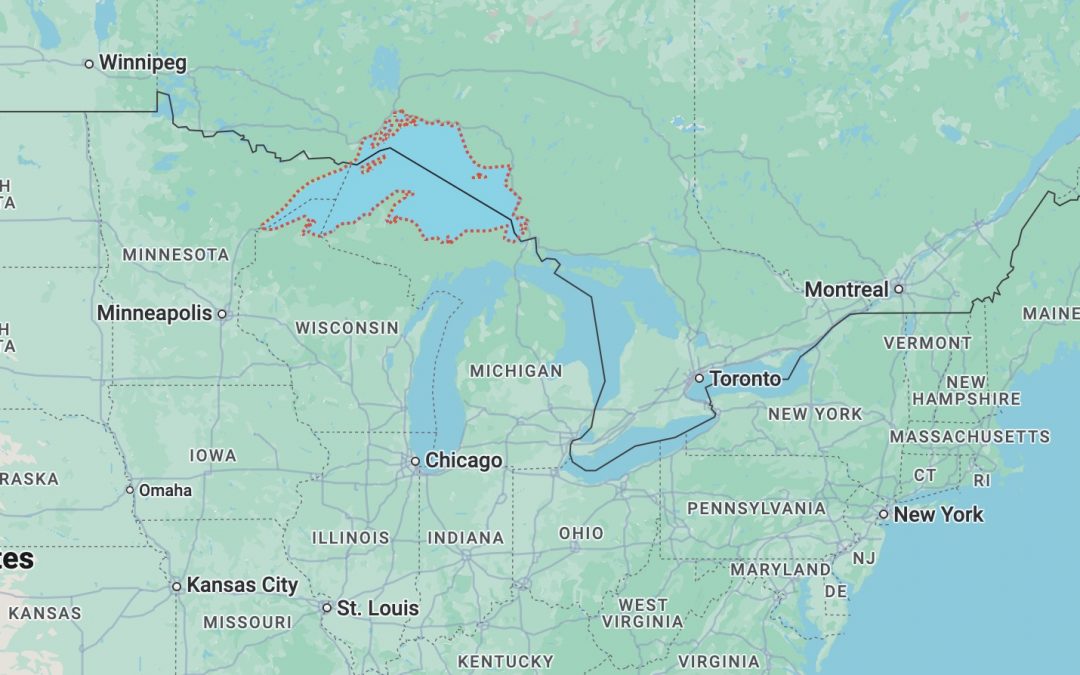The title of the largest freshwater lake in the world by surface area is held by Lake Superior. This magnificent lake, part of the Great Lakes of North America, is known for its immense size, natural beauty, and ecological significance. Here are detailed insights into Lake Superior:

View from Minnesota over Lake Superior; the World’s Largest Fresh Water Lake
Physical Characteristics of the World’s Largest Freshwater Lake:
- Surface Area: Lake Superior covers approximately 31,700 square miles (82,100 square kilometers), making it the largest freshwater lake by surface area.
- Volume: It has a volume of about 2,900 cubic miles (12,100 cubic kilometers), making it the third-largest freshwater lake by volume, after Lake Baikal in Siberia and Lake Tanganyika in Africa.
- Depth: The average depth of Lake Superior is about 483 feet (147 meters), and its maximum depth reaches 1,333 feet (406 meters).
- Shoreline Length: The lake has a shoreline that stretches over 2,726 miles (4,387 kilometers), including islands and touches both Canada (Ontario) and the United States (Minnesota, Wisconsin, and Michigan).
- Altitude: The lake sits at an elevation of approximately 600 feet (183 meters) above sea level.
Location:
- Geographical Area: Lake Superior is situated on the border between the United States and Canada. It is bordered by the U.S. states of Minnesota, Wisconsin, Michigan, and the Canadian province of Ontario.
- Coordinates: Approximately 46.5°N latitude and 87.5°W longitude.
History:
- Formation: Lake Superior was formed during the last glacial period around 10,000 years ago when retreating ice sheets carved out the basin that would become the lake.
- Indigenous History: Indigenous peoples, including the Ojibwe, have lived around Lake Superior for thousands of years and have deep cultural and spiritual connections to the lake.
- European Exploration: Europeans first encountered the lake in the early 17th century. French explorers named it “Lac Supérieur,” meaning “Upper Lake” because it is upstream of the other Great Lakes.
Ecology:
- Biodiversity: The lake is home to a diverse range of fish species, including lake trout, whitefish, and herring. It also supports a variety of bird species, mammals, and plant life.
- Clear Water: Lake Superior is known for its remarkably clear water, with visibility reaching up to 27 feet (8 meters) in some areas. This clarity is due to its relatively low nutrient levels.
Economic and Cultural Significance:
- Shipping and Transport: Lake Superior is part of the Great Lakes waterway, playing a crucial role in the shipping of goods such as iron ore, coal, and grain. The lake is connected to the Atlantic Ocean via the St. Lawrence Seaway.
- Recreation and Tourism: The lake and its surrounding areas offer numerous recreational opportunities, including fishing, boating, kayaking, hiking, and camping. Popular destinations include Isle Royale National Park, the Pictured Rocks National Lakeshore, and the Apostle Islands.
- Cultural Heritage: The lake has inspired countless works of art, literature, and music, and it continues to hold cultural significance for both indigenous peoples and local communities.
Fun Facts about the Largest Fresh Water Lake In The World:
- Shipwrecks: Lake Superior is known for its numerous shipwrecks, including the famous SS Edmund Fitzgerald, which sank in 1975. The Great Lakes Shipwreck Museum in Michigan memorializes these maritime tragedies.
- Cold Waters: The lake’s waters remain cold year-round, with an average temperature of about 40°F (4°C). This cold temperature contributes to the lake’s clarity and the preservation of shipwrecks.
- Weather Influence: Lake Superior significantly influences local weather patterns, creating lake-effect snow in the winter and moderating temperatures in the surrounding regions.
Conservation:
- Protection Efforts: Numerous organizations and governmental bodies work to protect and preserve Lake Superior’s natural environment. Efforts include monitoring water quality, managing fisheries, and addressing pollution sources.
- International Collaboration: The United States and Canada collaborate on initiatives to protect the Great Lakes through agreements such as the Great Lakes Water Quality Agreement.

Lake Superior is the World’s Largest Fresh Water Lake
Lake Superior’s sheer size, natural beauty, and ecological importance make it a vital and cherished part of both the United States and Canada. Whether you’re an outdoor enthusiast, a history buff, or simply someone who appreciates natural wonders, Lake Superior offers an incredible and inspiring experience. If you have the chance to visit, exploring its vast shoreline, crystal-clear waters, and surrounding wilderness is an unforgettable adventure.

